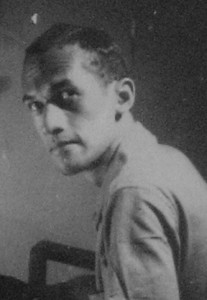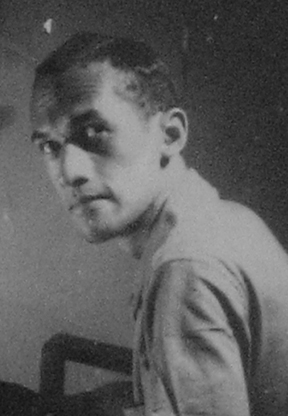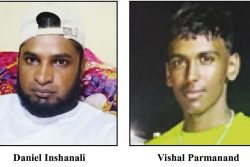By Juanita Cox
Juanita Cox is a PhD student writing her thesis: ‘Edgar Mittelholzer and the Shaping of his Novels’ at the University of Birmingham, UK. Her interests include Caribbean literature, culture and history and a version of this article will be appearing as a chapter in a book, Caribbean Voices, soon to be published. She is also currently working on an introduction to Corentyne Thunder, Mittelholzer’s first novel, which is due to be republished in 2009. She has lectured in Caribbean Studies at the London Metropolitan University.
“[Literature] is the creation of actual men and women, actually living in an identifiable set of historical circumstances, themselves both the creatures and creators of their times.”
Eldridge. C. (ed.)The Imperial Experience: From Carlyle to Forster
(Macmillan Press: London, 1996) pp xi-xii
Part 1
Edgar Austin Mittelholzer was born in New Amsterdam, British Guiana in 1909 to near-white middle class parents of mixed European and African extraction, both of whom were unable to mask the colour/race prejudice that his swarthy complexion aroused in them. In the late 1920s he made the radically unconventional decision to become a professional writer, much to the deepening dismay of his parents and scorn of New Amsterdam society. By the time he had committed suicide in 1965 through self-immolation, Mittelholzer had over twenty published novels, a travel journal and an autobiography to his credit. Whilst critics, and in particular Seymour, Gilkes and Birbalsingh, have carried out illuminating analytical studies of his novels, no book-length examination of his life and works has as yet been published.
This article hopes to generate renewed interest in Mittelholzer by focusing on an aspect of his literary career that has hitherto been ignored; namely his involvement in the BBC’s Caribbean Voices radio programme. Transcripts of the programmes broadcast between 1945 and 1958, reveal that his relationship with Caribbean Voices spanned the whole period of its existence. He contributed firstly as a writer of short stories and poems; then as reader of submissions for broadcast. As a literary pioneer his works became the focus of critical attention until he later, as an established author, took on the important role of programme editor/presenter (1956-1958). By analysing the contents of these transcripts in conjunction with the behind-the-scenes correspondence, held in the University of Birmingham’s Henry Swanzy Collection, this article aims to reflect upon Mittelholzer’s contribution to the development and evolution of Caribbean literature during the mid-to-late 1940s and 1950s. Attention will also be given to the illuminating insights that these archives provide, particularly with respect to the author’s life, his attitudes to writing, thematic concerns and the shaping of his novels.
Mittelholzer’s first contribution to Caribbean Voices pre-dates the appointment of the highly acclaimed programme editor, Henry Swanzy (1946-1953), and resulted in the broadcast on 29th November 1945 of an essay which had earlier that year been published in BIM: Of Casuarinas and Cliffs. The contents of this essay are worthy of comment. In recalling the assertions of a despondent artist that: “There’s just nothing in Barbados to paint” , Mittelholzer goes on to avidly reflect on the esoteric beauty of the Barbados landscape; the forbidding “dignity” of Hackleton’s Cliff, the awesome mystery of “swishing” Casuarinas and the “too-blue-to-be-true” sea. If he couldn’t persuade the artist that he had something to paint, then at least in writing the essay he hoped to persuade others that there was much, within the Caribbean, to inspire the would-be writer.
This was no insignificant objective for as A J Seymour remarked, in the 1967 Edgar Mittelholzer Memorial Lectures, one sensed in the early part of the twentieth century that the majority of educated West Indians A J Seymour remarked, in the 1967 Edgar Mittelholzer Memorial Lectures, one sensed in the early part of the twentieth century that the majority of educated West Indians believed it was “positively indecent” for anyone to contemplate becoming a professional creative writer and moreover that it was totally unfeasible exercise for: “what on earth could you write about?”; everything worth saying had already been said, whilst nothing of “evocative appeal” was believed to exist in the Caribbean. Far from regretting the absence of Wordsworth’s daffodils or Keat’s nightingales, it is evident from the keenly observed representations of the Caribbean landscape in his first published novel Corentyne Thunder (1941) and those that followed, that Mittelholzer believed very strongly in the validity of the world around him.
 Indeed in terms of his evolution as a writer, it is important to recognise that most of the material Mittelholzer garnered for his Caribbean-set novels date back in one way or another to the pre-1950s period. Eltonsbrody, a novel that was not published until 1960 was, like Of Casuarinas and Cliffs, inspired by a short visit he had made to the Scotland District of Barbados in March 1944. By December 1945, according to a letter he wrote to Collymore, he was already in the process of re-writing Eltonsbrody and hoped to have it “complete…in another three or four weeks”. In the same letter Mittelholzer made reference to another novel that he had already completed: “There’s no word yet of The Story of Sylvia. Harper’s have now had it eight weeks clear…” Mittelholzer’s confidence that this novel would eventually be published was realised in 1953 when it appeared as The Life and Death of Sylvia. Later in 1946 he began work on a gothic tale based on a trip he had made to “the jungle of the Berbice River” in 1933. The tale almost certainly evolved into My Bones and My Flute (1955), whilst material from this trip undoubtedly influenced many features of Shadows Move Among Them (1951). The Adding Machine (1954) a less well-known novella of 20,000 words was written sometime between June 1942 and January 1943 , whilst his novel, A Morning at the Office (1950), was completed by February 1948. Even the Kaywana trilogy, which involved many years of research, was according to a letter Mittelholzer wrote to Swanzy conceived in the1930s/40s:
Indeed in terms of his evolution as a writer, it is important to recognise that most of the material Mittelholzer garnered for his Caribbean-set novels date back in one way or another to the pre-1950s period. Eltonsbrody, a novel that was not published until 1960 was, like Of Casuarinas and Cliffs, inspired by a short visit he had made to the Scotland District of Barbados in March 1944. By December 1945, according to a letter he wrote to Collymore, he was already in the process of re-writing Eltonsbrody and hoped to have it “complete…in another three or four weeks”. In the same letter Mittelholzer made reference to another novel that he had already completed: “There’s no word yet of The Story of Sylvia. Harper’s have now had it eight weeks clear…” Mittelholzer’s confidence that this novel would eventually be published was realised in 1953 when it appeared as The Life and Death of Sylvia. Later in 1946 he began work on a gothic tale based on a trip he had made to “the jungle of the Berbice River” in 1933. The tale almost certainly evolved into My Bones and My Flute (1955), whilst material from this trip undoubtedly influenced many features of Shadows Move Among Them (1951). The Adding Machine (1954) a less well-known novella of 20,000 words was written sometime between June 1942 and January 1943 , whilst his novel, A Morning at the Office (1950), was completed by February 1948. Even the Kaywana trilogy, which involved many years of research, was according to a letter Mittelholzer wrote to Swanzy conceived in the1930s/40s:
I’m hard at work on a big historical novel [that] is the first of a trilogy. All the research work was done years ago when I was in B.G. [i.e., pre 1941] and now it’s merely a matter of doing the spade work of writing.
Furthermore, although part three of A Tale of Three Places (1956), which is set in St Lucia, was presumably written after a trip Mittelholzer made to the island in December 1954, parts one and two, set respectively in Trinidad and England, were commenced around April 1948 and neared completion in the December of that year. Of his published Caribbean-set novels it is only The Mad MacMullochs, written in 1953 and first published in 1959 under the pseudonym H. Austin Woodsley: Of Trees and the Sea (1956), The Weather Family (1958), Latticed Echoes (1960) and Thunder Returning (1961); the latter two being a response to his brief visit to Guyana in February 1956, which appear to have been conceived after the 1940s period. It is difficult in the absence of his original manuscripts to access the impact of these long periods of gestation on his writing. However, it might speculatively explain why the belief systems which Mittelholzer expressed in his novels appear at times to be contradictory: a consequence perhaps of the merging of attitudes which had changed over time.
The point here is also to suggest that had both local and global conditions in the 1940s been different Mittelholzer would (hypothetically-speaking) have provided the link between the older generation of Caribbean writers and those who appeared alongside him in the 1950s . Caught in the maelstrom of history; the 2nd world war and his conscription to the Trinidad Royal Naval Volunteer Reserve (Dec 1941 – Aug 1942), Mittelholzer’s literary ambitions were inevitably hampered. Correspondence reveals however that by the mid-1940s, he had re-established regular contact with the publishing industry, paying scant regard to the numerous obstacles he would have to face. The author’s remarks, made in a letter sent to Collymore in September 1945, help to provide some exemplification of this:
Macmillan’s wrote telling me that “in the final analysis (they) were forced to decide against a book of (mine). As Ms Cole wrote (me) in June the paper and labour situation (in the U.S.) is really very serious indeed”, etc. It appears that only established authors have any real chance of getting anything published this year, owing to the cut in the paper quota and the labour shortage.
It was thus on account of the economic difficulties in the immediate aftermath of the war, (as well as the absence of publishing houses within the region), that Mittelholzer’s dream of becoming a well-known novelist arguably remained virtually impossible until the 1950s. The most that Mittelholzer could realistically hope for during the 1940s was the publication of his short stories, articles, sketches and poems, in local papers such as the Trinidad Guardian or regional journals like Caribia, BIM and Kyk-Over-Al. Archival evidence reveals that he not only took advantage of all of these avenues but as importantly, the opportunities presented by the BBC’s Caribbean Voices programme.
In addition to the already mentioned, Of Casuarinas and Cliffs, Caribbean Voices transmitted the following short stories and sketches, several of which also appeared in BIM: Carnival Close-Up (1947), Pawpaw Tree (1947), The Burglar (1948), Tacama (1948), The Trip to Berbice (1949), Sorrow Dam and Mr Millbank (1949), Mr Jones’s Little Problem (1949), Amiable Mr Britten (1950), The Sibilant and the Lost (1950), A Plague of Kindness (1950), Wedding Day (1951) and Hurricane Season (1954); as well as a few poems such as Island Tints (1948) and In the Beginning – Now – and Then (1950).
These stories and poems are, as concise, single-themed pieces of work, an invaluable resource for critics interested in the evolution of Mittelholzer’s beliefs, attitude to life and thematic concerns. Whilst not being samples of Mittelholzer at his literary best, stories such as the Sibilant and the Lost provide, for instance, clear evidence of his early interest in ‘oriental occultism’ and indicates, through direct references to Yoga, Nirvana and Gautama, that religion was as the author often declared, one of his key preoccupations. Whilst Gilkes importantly highlights in his article, The Spirit in the Bottle, that Mittelholzer’s occultist beliefs are apparent in several of his novels, religion is as a theme, an aspect of his work that has generally been ignored, misunderstood or misinterpreted. A partial explanation for this can be found in a letter Mittelholzer wrote to A J Seymour in January 1959:
[A Tinkling in the Twilight (1959)] is the first time that I’ve cared to bring out so clearly into the open my strong attachment to Oriental occultism and Yoga. I’ve held these beliefs since I was 19, but in my writings have never liked to reveal them because I knew perfectly well I can prove nothing I say on the basis of plain logic (and unfortunately, the Western World can only be convinced by “rational” arguments).
Nevertheless, it seems likely that an analysis of Mittelholzer’s literary works both pre and post-1959, would be aided by an understanding of ‘oriental occultism’, and the primary texts that shaped his religious beliefs. It is arguably clear furthermore that this would be as the author intended. In A Tinkling in the Twilight Mittelholzer’s semi-autobiographical protagonist is careful to highlight the sources of his thinking: e.g., Yogi Ramacharaka’s, Advanced Course in Yogi Philosophy and Oriental Occultism. A cursory examination of Yogi Ramacharaka’s teachings (a broadly interpreted account of Hindu religious philosophy) raises points of interest for his literary critics. Did, for instance, Ramacharaka’s writings (which reveal the Yogi’s unquestioned acceptance of pseudo-scientific racism) have a conscious/subconscious impact on Mittelholzer’s ambivalent racial attitudes? Can it shed any light on the author’s preoccupation with such themes as strength versus weakness and spirit versus flesh? Did these occultist beliefs, unorthodox for a person of his background, increase the author’s sense of alienation, his literary representations of suicide and indeed that of his own?
The writing of short stories (as will be highlighted later on in this article) was not, importantly, a genre that Mittelholzer particularly favoured. In the aftermath of the war he enlisted the help of a literary agent based in England. Following eight rejections of his novel A Morning at the Office, Mittelholzer went a step further by deciding to take direct control over his own affairs. On February 9, 1948, he boarded the S. S. Ariguani arriving in Avonmouth, England, some three weeks later. On the sixth day of his arrival, Mittelholzer wrote to the BBC enquiring about the possibility of contributing to the West Indian Section of their broadcasts. By April 1948 he was being employed as a reader on Caribbean Voices and had additionally, less than two months later, secured a job as a typist in the Books Department of the British Council. Whilst not initially being, as Lindo remarked to Swanzy, “a good reader”, Mittelholzer represented one of the first Caribbean-born individuals, to read the literary submissions which were broadcast. Since some of the prose experimented with West Indian dialect, authentic regional accents would have been in most cases, and as Swanzy believed, preferable to the alternative option of employing trained English actors. Mittelholzer’s role as a reader would also have alerted Caribbean writers back home, especially in British Guiana and Trinidad where he was well known amongst the emerging literary set, of the possibilities of employment in the UK. His involvement with the programme and friendship with Henry Swanzy meanwhile helped him to maintain his links with the Caribbean literary scene and offered him practical experience of radio broadcasting, which he would draw upon later on in his career.
His job as reader also enabled him to supplement the meagre wages that he was earning at the British Council. These same economic pressures seemingly informed his decision to write short stories for the programme:
I might have mentioned…the short story is not my favourite medium. Whatever spare time I have I generally devote to work on a novel. I write these short stories for you, to be honest, merely to secure the wherewithal to buy my season ticket to and from Bagshot!
With the exception of Hurricane Season, Mittelholzer stopped submitting material to Caribbean Voices in mid-1951; a juncture in his life which correlates with the financial security he had attained following the publication of his third novel, Shadows Move Among Them. His preference for the novel as a medium of writing helps, at least in part, to account for his relatively small contribution to the body of short stories in the Caribbean Voices collection. Other significant explanations are rooted in the fact that his submissions were at times unsuitable for radio broadcast, either because they were too long or involved too many characters. Aside from this, some of his material wasn’t liked, as in the case of Romantic Promenade (1946); a story rejected on the grounds of being “too wet”. Many like Swanzy, Collymore and Lindo did not resultantly have high expectations of Mittelholzer’s ability to succeed as a writer. These opinions were however to be dramatically challenged with the publication of A Morning of the Office. As Swanzy remarked in a letter to Collymore:
…the great topic here is the success of Edgar Mittelholzer’s novel. It is really extremely good, crisp, fast, colourful, humorous, and I for one have to rub my eyes to remind myself that this is the same old Edgar who looks in with long and rather drab pot boiling short stories.
The positive outcome of Mittelholzer’s relocation to Britain would not have gone unmissed by his literary counterparts back in the Caribbean. His success arguably encouraged others not only to hold strong in pursuit of their literary aspirations, but also consider the possible benefits of moving to Britain. As Swanzy observed in a letter to Gladys Lindo:
I suppose that the [Caribbean Voices] programme may be indirectly responsible for luring so many young adventurers here, and I must say that I respect the desire for wanderjahre. Obviously, one does not altogether want to discourage the more promising from chancing their arm and reaping experience, even if not pounds, shillings and pence… The task is not made any easier by the success of Edgar Mittelholzer, whose novel is really outstandingly good, much the best I have ever read about the West Indies, and very high in contemporary English writing I should think… His novel, and the West Indian cricketers, may give some openings to the writers in London…” [my italics]
With publishers’ more attuned to the marketability of West Indian literature, Swanzy’s predication was destined to become reality. Apart from the successive publication of his own novels, Shadows Move Among Them (1951), Children of Kaywana (1952) and The Weather in Middenshot (1952), novelists such as Selvon, Lamming and Mais received their first major breaks with the respective novels: A Brighter Sun (1952), In the Castle of My Skin (1953) and The Hills were Joyful Together (1953).
Whilst the critical success of, A Morning at the Office, generated much behind-the- scenes excitement about the future of West Indian literature, certain aspects of Mittelholzer’s novel were to become the subject of controversy. Like Swanzy, Collymore and others, Cedric Lindo was to acknowledge in a letter dated June 1, 1950, that he had thoroughly enjoyed reading Mittelholzer’s novel. His following observation was however to act as a catalyst of debate:
Am I mistaken or was there a dig at Henry Swanzy, Arthur Calder Marshall et al in the reference to the faddists who insist on West Indian culture?
Less than four weeks later in a West Indian Symposium transmitted by Carib-bean Voices on July 9, 1950, Calder Marshall, the chairman, questioned whether Mittelholzer shared the view expressed by one of his characters that: “West Indian culture was invented by faddists.” In response to this Mittelholzer clarified that from his perspective culture wasn’t something that West Indians could consciously or deliberately create. He went on to argue that:
…a culture that is truly West Indian would have to be one that derives from the whole mass of conflicting racial influences – not only from the African – for the West Indian colonies aren’t populated solely by Africans. We have East Indians, Portuguese, Chinese, Spaniards, Assyrians, [and] English.
Whilst he went on to argue that the role of the writer was to focus on “universal” concerns and qualities of “human nature”, with some like Sam Selvon agreeing, others like Alfred Mendes and Doreen G. Grayson maintained that the focus needed to be more inward looking and regional; the latter championing the development of folklore over the possibility of becoming “the imitation of a British Council dummy.” With Caribbean Voices used as a forum for public debate, A Morning at the Office inevitably became an important platform through which views on the various possible directions of West Indian literary culture could be formed and consolidated.
Between mid-1951 and mid-1956 Mittelholzer’s direct involvement with Caribbean Voices virtually ceased. Based on the correspondence held in the Henry Swanzy collection and other supportive material held in the Frank Collymore collection, it is possible to speculate why. Firstly financial security and publishing success had enabled Mittelholzer to fulfil his dream of becoming a career novelist and secondly as established writer, he no longer felt it necessary to continue living in the UK. In March 1952 he resigned from the British Council and when awarded, in the following month a Guggenheim Fellowship, spent three months researching historical material for his Kaywana Trilogy at the British Museum. At the end of August 1952, Mittelholzer and his family moved to Montreal, Canada where they aimed to settle. However on finding the climate intolerably cold and the exchange rate unfavourable – it drastically reduced the income he was making from sales of his books in the UK – the Mittelholzers decided to move yet again (in April 1953), this time to Barbados where the family remained until May 1956. It is also apparent from archival research that Mittelholzer believed, like Swanzy, that Caribbean Voices should be used as a forum to help nurture unknown writers and sensed that it would be inappropriate for him, as an established novelist, to continue submitting material for their use. As a pioneer and the most prolific of the 1950s writers, with a growing international readership his novels continued however to be monitored with interest and were in most instances, reviewed by producers of the Caribbean Voices programmes as and when they were published.
(The second part of this article will be published in the June 2008 issue of th Guyana Review)










